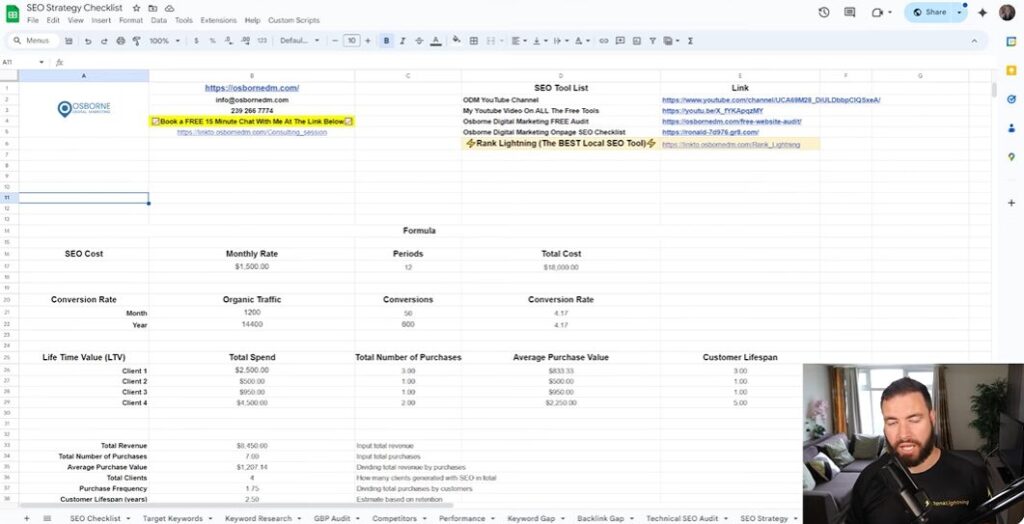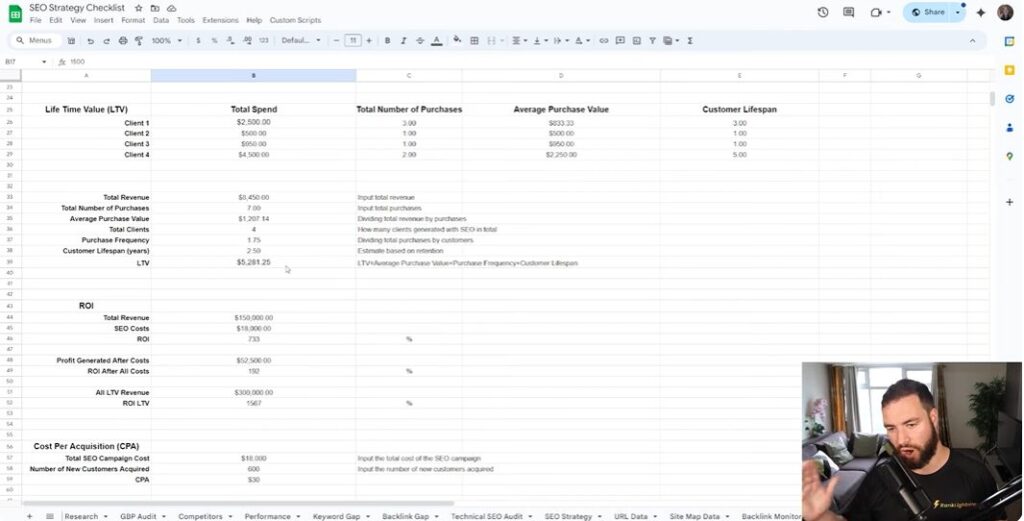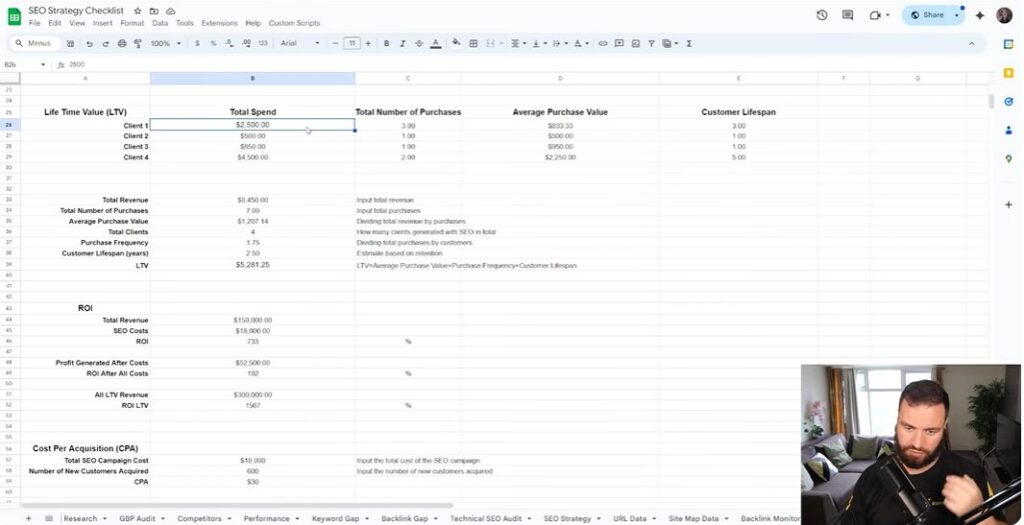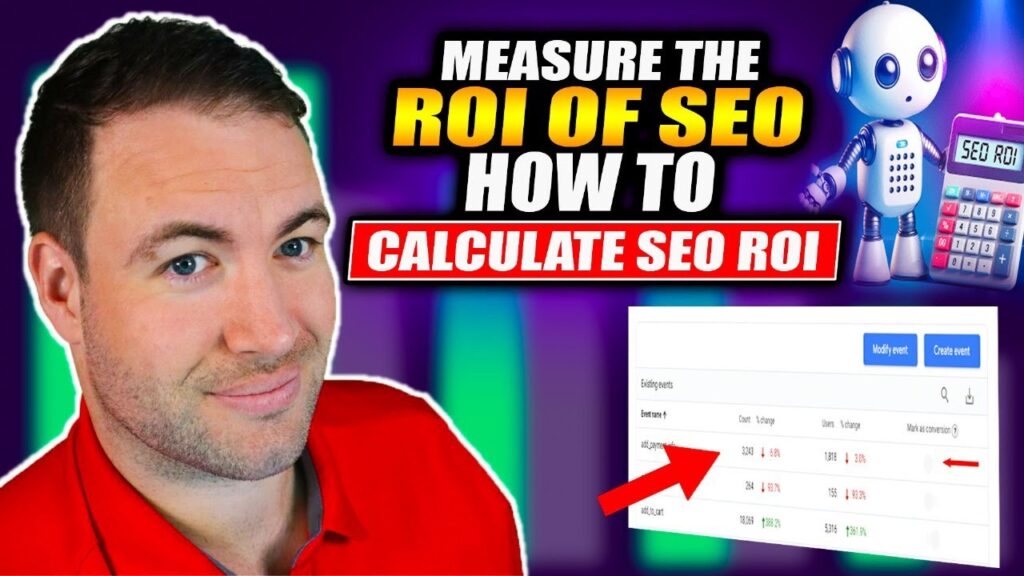Have you ever poured your heart and soul into an SEO campaign, only to wonder if it's really paying off? I remember when I first started my digital marketing agency; the results felt intangible, like trying to catch smoke with my bare hands. I learned quickly that if I wanted to succeed, I needed to get a grip on how to measure my ROI effectively through an SEO ROI Calculator. This post will share my journey and the exact steps I followed to demystify ROI calculations, ensuring that my clients understood the value of every penny spent.
TL;DR: Learn how to measure the ROI of your SEO campaigns with straightforward calculations, practical tools, and real-world examples that justify your investment and help retain clients.
Table of Contents
Understanding The Importance Of ROI In SEO
Let's talk about something crucial when you consider getting quality SEO services: ROI, or Return on Investment. You might wonder, why does measuring ROI matter for any SEO campaign? Well, the answer is simple yet profound. In the fast-paced digital landscape, it’s not just about improving website traffic or getting more clicks. It’s about ensuring that those clicks translate into actual revenue. That's the real win!
1. Why Measuring ROI Matters
Measuring ROI is essential for various reasons:
- Focus on Results: At the end of the day, clients and business owners want to see how their investments pay off.
- Data-Driven Decisions: Being able to analyze ROI helps us make informed choices about future campaigns.
- Building Trust: By showing data-backed results, we enhance our credibility with clients.
How can we track the actual effectiveness of an SEO campaign? It's all about understanding the metrics that matter, such as conversion rates and customer lifetime value (LTV). Without these, we're navigating in the dark.
2. Common Misconceptions About SEO Success
There are several myths about SEO success that I’ve encountered:
- All about organic traffic: Many believe that if traffic increases, success is guaranteed. Not true! What’s more important is the quality of that traffic.
- Quick Results: SEO doesn't work overnight. It's a long-term strategy, requiring consistent effort to see solid returns.
- SEO is a one-time task: Many think after they optimize, that's it! In reality, SEO is an ongoing commitment.
Being clear about these misconceptions helps set the right expectations with clients.
3. How ROI Influences Client Relationships
Now, let’s dive into how ROI influences client relationships. A strong focus on ROI fosters transparency and accountability. When I present results - like knowing how many leads turned into sales - clients feel more informed and engaged. It encourages an ongoing dialogue.
Imagine if you could explain to a client, "For every dollar spent on SEO, your revenue increased by three dollars!" How do you think that would make them feel? It builds trust and demonstrates value that extends beyond the numbers.
In conclusion, understanding ROI in SEO goes beyond just analytics. It lays the foundation for successful, lasting client relationships and aligns our goals with those of our clients. After all, we’re in this together!
Setting Up Your SEO ROI Calculator

Let's learn more into setting up an SEO ROI calculator with this guide. An effective ROI calculator will not only help you understand your SEO investments but also present insights that speak directly to your wallet. With my experience, I’ve seen that many people overlook this vital step.
Tools And Spreadsheets For Calculating SEO ROI
First up, you’ll need the right tools. A detailed spreadsheet serves as a compass for your SEO journey. I created a robust SEO ROI calculator as part of my free SEO checklist.
- This spreadsheet allows you to input monthly SEO costs.
- The tool also requires data on conversion rates and customer lifetime value (LTV).
- With these factors, you can clearly see the financial returns from your SEO efforts.
To put it simply, consider it your financial roadmap for SEO. Are you investing wisely? This tool will show you the way.
Gathering Necessary Data Points
Before you start inputting data, gather the necessities. You need:
- Monthly SEO costs: How much are you paying monthly for your services? Let’s say it’s around $1,500.
- Your business's current revenue: Understanding annual revenue is crucial. For instance, if your business makes $300,000 each year, this is your baseline for enterprise SEO.
- Conversion rates: How well is your traffic converting into sales?
Each of these information points is like a piece of a puzzle. Alone, they may seem small, but together, they create a clear picture.
Inputting Data: Costs, Conversions, And Sales
Now it’s time to input your data. Start with your monthly costs and multiply by the duration of the campaign. Make sure your figures are precise; even small inaccuracies can skew your results significantly.
Next up is the conversion rate. You can track this using tools like Google Analytics or Call Tracking systems, such as Dial Hawk. Why? Because traffic alone doesn't paint the full picture. You want to see how many leads translate into actual sales.
And let’s not forget about customer LTV. This metric shows how much money a single customer spends over time. Think of it this way: if you provide plumbing services, a customer may return multiple times. Each time they come back, that should count towards their LTV.
Finally, it all boils down to measuring ROI. You need to calculate total revenue gained from SEO minus the total investment made. This helps you see the tangible financial benefits from your hard work - helping to justify your efforts to your clients.
So, I ask you: Are you ready to make your SEO efforts more rewarding? Setting up your SEO ROI calculator is your first step!
Deep Dive Into Conversion Rates And Lifetime Value

When we talk metrics in digital marketing, two key players stand out: conversion rates and customer lifetime value (CLV). But how do we actually calculate these figures? Let's break that down.
1. How To Calculate Conversion Rate
Calculating conversion rates is a straightforward yet essential task for any marketer. It’s all about understanding the percentage of visitors who become customers. Simple, right? Here's the formula:
Conversion Rate = (Number of Conversions / Total Visitors) * 100
For example, if your site receives 1,000 visitors in a month and 50 of them make a purchase, your conversion rate is 5%. It's important to track these numbers accurately. I suggest using tools like Google Analytics. They make the tracking process less daunting.
2. Understanding Customer Lifetime Value (CLV)
Now, let's dive into customer lifetime value. CLV represents the total revenue a business can expect from a single customer throughout their relationship. It’s more than just a one-time transaction. Think of it like this: if a customer buys from you once, that’s great. But if they come back, it shows they trust your brand.
- To calculate CLV, use this formula:
- This helps you understand how much to invest in acquiring new customers versus retaining existing ones.
3. Why Tracking These Metrics Is Crucial For Your Strategy
So, why should we bother with all these calculations? Because data-driven decisions lead to better outcomes. Knowing your conversion rates can help optimize your marketing strategies. If conversion is low, maybe it’s time to evaluate your site’s user experience or marketing messages.
Likewise, understanding CLV helps prioritize customer retention tactics. After all, keeping existing customers is often cheaper than acquiring new ones. I’ve seen game plans centered on CLV lead to massive long-term gains.
In summary, keeping an eye on these metrics isn't just good practice; it's essential for effective marketing strategy. It can transform the way we approach our audience and make information our best friend. What do you think? Are you tracking your conversion rates and customer lifetime value yet?
Calculating Life Time Value And Presenting ROI To Clients

Step-By-Step Guide To Calculating Your Return On Investment
Calculating ROI can seem daunting, but it doesn’t have to be. Here’s a simple breakdown to help you through the process. All you need is some reliable information and a solid understanding of what you’re measuring.
- Determine Your Costs: Start by identifying all monthly costs tied to your campaign. For instance, if you're spending $1,500 monthly on SEO, that’s your baseline.
- Track Revenue: Calculate how much revenue you're generating from these efforts. This is the number you measure against your costs. If your business pulls in $300,000 annually, that’s a critical figure.
- Conversion Rate: Assess how many lead conversions arise from your SEO efforts. Tools like Google Analytics can be extremely helpful here. Even if traffic grows, it’s conversions that matter most.
- Calculate LTV: Understand customer lifetime value (LTV). This tells you the revenue generated from a single customer over time. For example, a plumber may have customers return for multiple services.
- Calculate ROI: Use the formula: ROI = (Total Revenue - Total Costs) / Total Costs. This gives you a percentage that represents your return on investment.
Creating Compelling Presentations With Your Data
Once you’ve calculated your ROI, it’s time to present it. A compelling presentation can mean the difference between conversions or lost leads. Here are some tips:
- Visualize It: Use graphs and charts to display information. Visuals can make complex information easier to grasp.
- Tell a Story: Frame your data in a narrative. Relate how your efforts directly enhanced revenue. This engages clients on a personal level.
- Be Concise: Keep your slides clean and focused. Limit yourself to one key message per slide for maximum impact.
Key Messages To Communicate To Clients
When speaking with clients, impactful communication is crucial. Here are some key messages to convey:
- Value Over Vanity: Focus on revenue, not just traffic. Clients need to see how their investments yield hard cash.
- Long-Term Benefits: Help them understand the LTV perspective. It’s not just about one sale, but the potential for multiple future transactions.
- Transparent Metrics: Clearly explain how you arrived at your numbers. Clients appreciate transparency and clear methodologies.
Remember, it's all about making the numbers speak for themselves in a way that resonates with your clients. Use real-world analogies where necessary, and you'll hold their attention. As we know, collecting accurate and meaningful information is the bedrock of this entire process. Don’t skip the details.
Real-Life Examples, Results, And Success Stories

Case Studies From My SEO Campaigns
When I first started my journey as a start-up SEO agency, I faced numerous challenges. However, with time, I learned to navigate these hurdles with a positive point of view. Here are some real-life examples that brought significant returns on investment.
- One of my clients in the e-commerce space saw their revenue soar by 150% over six months. We targeted specific, long-tail keywords that had lower competition.
- Another case involved a local service business. After optimizing their Google My Business profile and implementing local SEO strategies, they increased their leads by 200%. This meant more phone calls and, ultimately, more bookings.
Lessons Learned From Past Failures
Not every SEO campaign is a home run. I’ve had my fair share of failures. But each taught me something valuable:
- Relying solely on SEO without a strong content plan led to stagnation. I learned the hard way that content is king!
- I underestimated the importance of tracking conversions. It’s not just about getting traffic; it’s also about understanding how that webflow converts into revenue.
Ask yourself: Have I tracked my conversions properly?
How To Adapt Strategies Based On Outcomes
Learning from both successes and failures, I refined my approach. Here’s how I adapt my techniques:
- Regular Analysis: I often review the analytics to see what's working and what's not. For example, if a specific article isn’t generating traffic or showing a not so good performance, maybe it’s time for a rewrite or update.
- Flexibility: SEO trends change rapidly. I ensure I stay updated with the latest algorithm changes. This means adjusting my tactics quickly to fit new requirements.
- Feedback Loop: Communicating with clients regularly helps understand their needs better. I use this feedback to fine-tune my campaigns continuously.
In summary, every campaign and its results mold my next steps. With each case study and even failure, I grow. How do your techniques evolve?
Common Pitfalls When Measuring SEO Return Of Investment

When it comes to calculating the return on investment (ROI) for SEO, many people fall into traps that can lead to misinterpretation of information. I’ve seen it firsthand. Business owners often focus solely on vanity metrics like site traffic, overlooking the actual financial return that matters most. So, what are common misconceptions that can cloud our understanding?
Avoiding Common Misconceptions
One common misconception is treating all traffic as equal. Just because your page or website traffic is increasing, doesn't mean that's translating into profit. Think about it: if you have more visitors but no conversions, what’s the point? SEO is not just about high traffic; it’s about targeted traffic that converts. We must align our keywords with actual buyer intent. After all, traffic without conversion is just noise.
Why Some SEO Reports Can Be Misleading
I've read many SEO reports that make sweeping statements about success, yet fail to provide context. For example, seeing a 40% increase in traffic sounds impressive, right? But, if that traffic isn't converting and you are not measuring the value of those visitors, then it is merely a distraction. Misleading reports can create false confidence, making you think your SEO efforts are fruitful when they're not. We must question the information: are these visitors actually engaging with our business?
Tips To Ensure Data Accuracy And Relevance
- Use reliable tools. Tools like Google Analytics or customer tracking software provide insights that are based on real interactions.
- Focus on conversion rates. These should be tracked consistently to see how many visitors actually take the desired action.
- Analyze the customer lifetime value (LTV). How many times will a single customer return? This metric can really paint a clearer picture.
In my experience, understanding your current profit is crucial. If you have a yearly profit in the amount of $300,000, that will be the baseline for evaluating any changes after your SEO campaigns. Start with the information that matters. Don’t just chase numbers; chase value.
Ultimately, I constantly remind myself - and you should too - to scrutinize the details. Doing so positions you to make informed decisions that actually drive revenue and development. Is it time to revisit your SEO strategy?
Cost Per Acquisition Of SEO
When we dive into the financial side of SEO, one key metric stands out: the Cost Per Acquisition (CPA). It’s a simple yet powerful indicator of how much you’re spending to acquire a customer through your techniques.
Understanding CPA
At its core, CPA is about evaluating the effectiveness of your SEO strategy. But what does it really mean for businesses? Essentially, it reflects the relationship between the costs of implementing SEO and the number of customers you're gaining as a direct result.
Calculating Your CPA
I often find it helpful to break down the calculation into a few simple steps:
- Start by determining your total SEO costs over a specific period. This can include monthly retainer fees, tools you utilize, and even any SEO content creation expenses.
- Next, identify how many new customers you acquired during that same timeframe.
- Finally, use this formula to find your CPA:
CPA = Total Costs / Number of Customers Acquired.
For instance, say you spent $1,500 on SEO for a month and gained 30 new customers. Plugging these numbers into the formula, your CPA would be $50. This figure is essential for assessing whether your SEO investment is delivering tangible results.
Why Is CPA Important
Understanding your CPA can help address several questions:
- How does this compare with other marketing channels? If your CPA for SEO is lower than PPC or social media advertising, you may want to allocate more budget to SEO.
- Is my investment worth it? A high CPA might mean it’s time to refine your SEO tactics or explore other techniques.
- What’s my customer lifetime value (LTV)? This metric, when combined with CPA, gives you a clearer picture of overall profitability.
Realistic Expectations
Yet, while looking at CPA, it’s crucial to remember to use accurate information. Errors in projections can lead to tall tales about your SEO’s effectiveness.
The healthcare analogy comes to mind. Think of CPA like a medical check-up. It needs accurate input to provide a meaningful outcome. If wrong information enters the solution, the prognosis becomes cloudy.
Final Thoughts On CPA
In my experience, keeping track of CPA not only helps measure SEO strategy’s efficiency, but it also aids in client communication. By translating costs into understandable metrics, you can effectively demonstrate the value of SEO to clients. They want to know they’re getting what they pay for, right? So, let’s ensure that we provide them with those insights.
Final Thoughts: The Path Forward In SEO ROI Measurement
As I reflect on the journey we've taken through the intricacies of SEO ROI measurement, it becomes evident that understanding ROI is essential. It's not just about generating traffic, ranking boost in search engines, or flashy metrics; it’s about returning value to our businesses. We’re in a world where business owners are more concerned with actual returns than vanity metrics. They want to see a direct line from their investment to increased profit.
Embracing Continual Learning
In the fast-paced landscape of digital marketing, staying stagnant is never an option. SEO trends change almost daily. Continual learning and adaptation are crucial. As we gather information, we must also be ready to pivot our strategies based on what the numbers tell us. Think of it this way: If you’re sailing and the wind shifts, you don’t keep going in the same direction. You adjust your sails to reach your destination efficiently.
The Future Of SEO Metrics
Looking ahead, the future of SEO is bright, but it also requires an open-minded attitude. We can expect to see a greater emphasis on comprehensive analytics tools that unify various metrics into more digestible insights. The tools we currently use, such as the SEO ROI Calculator, will continue to evolve. They’ll surely incorporate new features that help us see the complete picture of our strategies.
Moreover, metrics like customer lifetime value (LTV) will take center stage. By analyzing not just the immediate returns but also the long-term relationships we build with customers, we can better gauge the true impact of SEO. It’s no longer sufficient to look at immediate sales. Instead, we should foster a holistic understanding of consumer interactions with our brands.
"The only way to do great work is to love what you do." - Steve Jobs
In this exciting evolution of our industry, let us not forget the importance of effective communication with our clients. They look to us to demystify these metrics and, in doing so, foster their ongoing commitment to SEO. Remember, it’s about providing insight that translates into value. The potential for growth is only limited by our imagination and our willingness to adapt. As we continue down this path, we pave the way for a more impactful and rewarding future in SEO.




